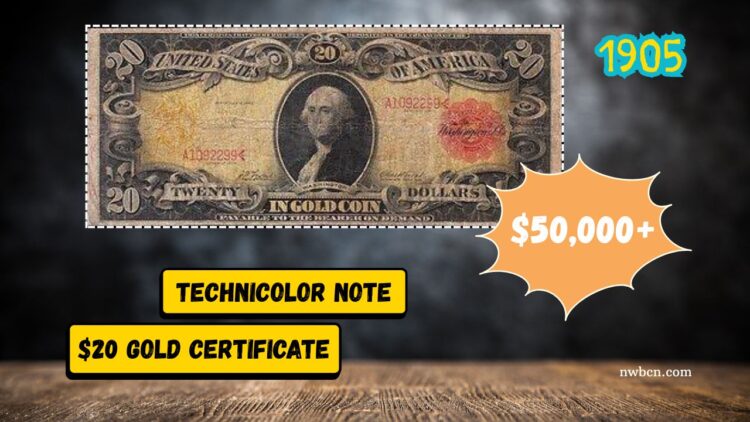The Series of 1905 $20 Gold Certificate, famously known as the “Technicolor Note,” is among the most visually striking and sought-after pieces in American numismatics.
Boasting intense red and yellow-gold tones, coupled with George Washington’s portrait, this large-size banknote captures collectors’ imaginations.
Design & Production Details
The note’s vibrant appearance earned it the nickname “Technicolor Note,” referencing its vivid palette:
- Portrait: A striking engraving of George Washington, adapted from Gilbert Stuart’s earlier work
- Color Scheme: Red Treasury seals and serial numbers, black, white, gold, and red on the face; back features an elaborate orange-gold design
- Engravings: Front by Alfred Sealey; back by Robert Ponickau
- Series Run: Issued only from 1905–1906; succeeded by the Series of 1906 with a yellow-gold seal and plain paper
Signature combinations include:
- FR-1179: Lyons (Register) and Roberts (Treasurer)
- FR-1180: Lyons and Treat
Why It’s Called “Technicolor”
While the name evokes Hollywood film, it simply highlights its bold coloring—red, gold, and orange tones unlike any other large-size gold certificate. The vibrant color scheme was a one-off experiment before the Treasury pivoted to more restrained designs.
Rarity & Census Counts
The Track & Price census currently lists approximately 567 known Series 1905 Technicolor Notes. Within this group, unique examples and high grades are extremely rare, making them exceptionally desirable to collectors.
Notable Examples & Auction Records
- Serial Number 1 from President Theodore Roosevelt’s collection sold for $552,000 in August 2018
- A PMG‑12 Fine note sold for $2,280 in November 2023
- A PCGS Superb Gem UNC 67 PPQ was listed at $78,000 in 2021
- Gem-condition specimens like PMG 64 and PCGS S/U 67 are frequently priced between $40,000–$80,000, depending on eye appeal
Market Overview & Values
| Grade & Certification | Price Range (Approx.) | Notes |
|---|---|---|
| VG–10 | $1,250–$2,500 | Heavily circulated with good coloration |
| VF–30 | $5,000–$10,000 | Bright color, light handling marks |
| XF–45 to AU–53 | $10,000–$25,000 | Strong impression, vivid details |
| UNC (PMG 64–67) | $40,000–$80,000+ | Superb eye appeal, bold color |
Why Collectors Love It
- Visual Appeal: One of the most colorful large-size U.S. banknotes ever produced
- Historical Links: Closely tied to Theodore Roosevelt, a driving force behind the early 20th-century dollar redesign
- Limited Run: Only printed a short time, ensuring scarcity
- Gem Investment: High-grade specimens are rare, making them desirable for serious collectors and investors
Ongoing Market Trends
Demand is steady, especially for premium specimens. Gem-quality notes are often purchased privately or consigned to major auction houses. While mid-grade examples increasingly sell wholesale trending upward, only top-condition notes break past the $50,000 barrier.
Tips for Buyers & Collectors
- Grade Matters: Choose notes graded PMG 30+ for significant color retention and investability
- Seal & Serial Combinations: FR‑1180 with Lyons–Treat is slightly rarer; FR‑1179 (Lyons–Roberts) is more commonly seen
- Eye Appeal: Bold colors, sharp reds, and unmarred paper distinguish the top-tier notes
- Provenance: Roosevelt-owned Serial No. 1 notes are among the most historically significant
The 1905 “Technicolor Note” $20 Gold Certificate is not merely a piece of currency—it’s a visual marvel and a window into early 20th‑century American design and history.
From vibrant inks and intricate engravings to its association with Theodore Roosevelt and its rarity, it commands attention both for aesthetic beauty and investment potential.
Whether a collector seeks a mid-grade piece or strives for gem-level perfection, the Technicolor Note offers a rich, colorful path to owning a piece of American numismatic storytelling.
FAQs
1. What makes the Technicolor $20 Gold Certificate unique?
Its vivid red seals, gold-toned field, and elaborate orange-gold back set it apart from all other large-size gold certificates. Issued only in 1905–1906, its design was a one-time experiment in aesthetic boldness.
2. How rare is a high-grade Technicolor note?
Only a few hundred survive, and gem‑grade specimens (PMG 64+) are exceedingly rare. The census lists 567 known notes, but only a handful reach UNC ranks and sell above $50,000.
3. Can I still legally buy and own a Technicolor Gold Certificate?
Yes. Ownership of gold certificates became legal again in 1964, although they are no longer redeemable for gold. These notes are collectible, not currency, and typically traded through reputable dealers or auctions.
